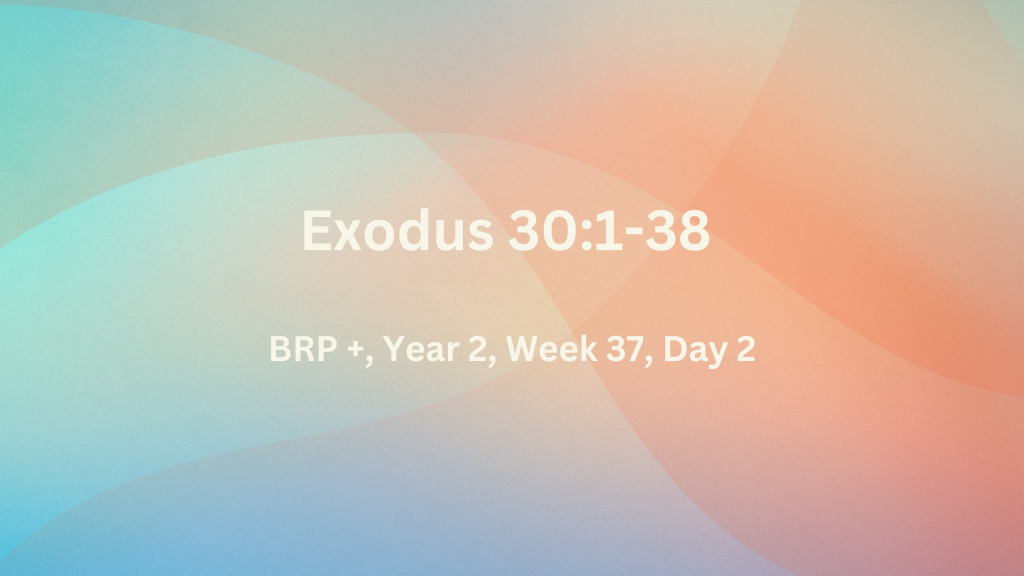Exodus 30:1-38
Q.1. How was the altar of incense made? Where was it placed? What could be burnt on this altar? When was the blood applied? – (Exo.30:1-10)
The altar of Incense was one cubit square and two cubits high made of acacia wood and overlaid with gold (Exo.30:1-3). It had horns on the corners, and two rings for its transportation with two poles … all overlaid with gold (Exo.30:2-5). This altar was placed – … in front of the veil that is near the ark of the testimony, in front of the mercy seat that is over the ark of the testimony, where I will meet with you (Exo.30:6). Every morning at sunrise and again at twilight – There shall be perpetual fragrant incense before the Lord throughout your generations (Exo.30:8). This altar was exclusively used to burn the fragrant incense, except that – Aaron shall make atonement on its horns once a year; he shall make atonement on it with the blood of the sin offering of atonement once a year throughout your generations. It is most holy to the Lord (Exo.30:10). No strange incense or any other offering was permitted on this altar (Exo.30:9). The blood was applied just once a year.
Q.2. What payment had to be made at a census? Why? Who paid it? Who was it for? For what was the bronze laver? Why was it needed? Where was it located? – (Exo.30:11-21)
David brought a plague on the land when he ordered a census to gloat over the size of his army (c.f. 2 Sam.241-4, 15-25). From time to time, God ordered a census to remind the nation that they were a ransomed people who required a payment of half a shekel for every son over twenty years of age (Exo.30:11-14 c.f. Num.2:32-33; 3:11-13, 40-51). All were treated alike – The rich shall not pay more and the poor shall not pay less than the half shekel when you give the contribution to the Lord to make atonement for yourselves (Exo.30:15). These gifts supported the service of the tent of meeting as – … a memorial for the sons of Israel before the Lord, to make atonement for yourselves (Exo.30:16). A bronze laver was located at the entrance of the tent of meeting. The water in the laver enabled Aaron and his sons to – … wash their hands and their feet, so that they would not die; and it would be a perpetual statute for them, for Aaron and his descendants throughout their generations (Exo.30:21).
Q.3. How was the anointing oil and incense made? For what were they used? Could the ingredients be used for themselves? – (Exo.30:22-38)
The recipe for the anointing oil, and the incense to be used in the tabernacle, was given by the Lord. Its fragrances were exclusively for the temple service. They were not to be duplicated for common use (Exo.30:32-33, 37-38). The anointing oil was a combination of the finest spices – myrrh, cinnamon, fragrant cane, cassia, and olive oil (Exo.30:22-25). All the furniture was to be anointed with this fragrant smelling oil – the tabernacle, the ark, the table, the lampstand with its utensils, the altar of incense, and the laver – You shall also consecrate them, that they may be most holy; whatever touches them shall be holy (Exo.30:29). It was also used to consecrate Aaron and his sons – 30 … that they may minister as priests to Me. 31 You shall speak to the sons of Israel, saying, ‘This shall be a holy anointing oil to Me throughout your generations (Exo.30:30-31). The ingredients for the incense were also a unique combination of crushed spices – 34 … stacte and onycha and galbanum, spices with pure frankincense; there shall be an equal part of each. 35 With it you shall make incense, a perfume, the work of a perfumer, salted, pure, and holy (Exo.30:34-35). It gave a special fragrance – before the ark of testimony in the tent of meeting where I will meet with you; it shall be most holy to you (Exo.30:36). A fragrance rose from the tabernacle, where God was pleased to dwell above the Mercy Seat.

